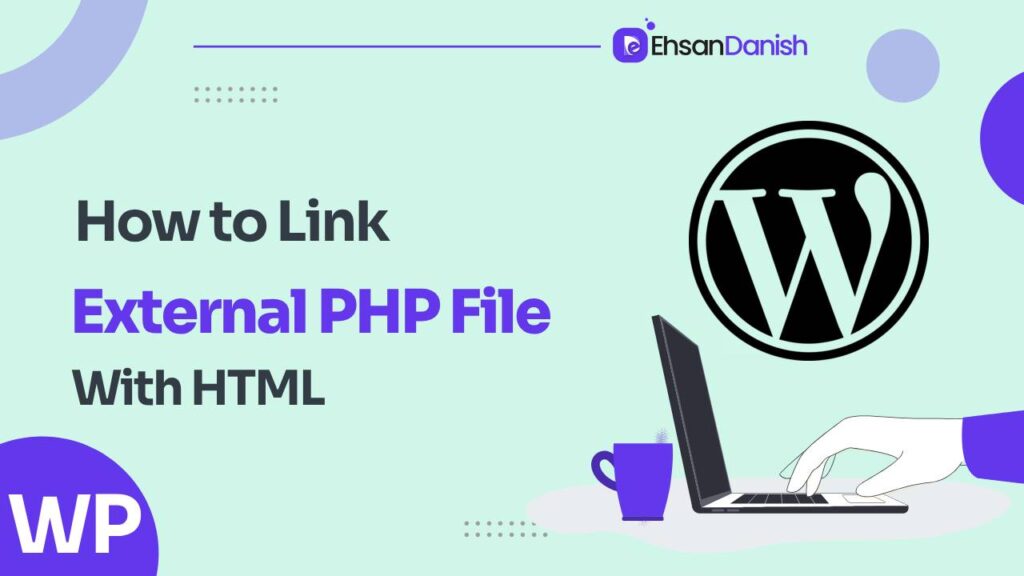In the realm of web development, the process of incorporating PHP scripts into HTML documents, often referred to as “How to Link External PHP File to HTML,” is a fundamental skill. PHP, being a server-side scripting language, empowers developers to create dynamic web pages and interactive web applications. By seamlessly integrating external PHP files with HTML documents, you unlock the potential of PHP to elevate the functionality and interactivity of your website. This article will explore the reasons for linking external PHP files to HTML and elucidate two distinct methods for achieving this integration.
Why Link External PHP Files to HTML?
Understanding the rationale behind the integration of external PHP files with HTML is crucial before delving into the methods. Here’s why this practice is indispensable in web development:
- Modularization: The integration of external PHP files with HTML facilitates code modularization. This approach segregates PHP logic from HTML markup, leading to a more structured and easily maintainable codebase.
- Code Reusability: External PHP files are incredibly versatile; they can be reused across multiple HTML pages. Rather than duplicating code for similar functionality on various web pages, you can incorporate the same PHP file in numerous locations.
- Enhanced Security: Separating PHP from HTML can bolster security. PHP files may contain sensitive information, and maintaining this separation mitigates the risk of inadvertent exposure of sensitive data.
Now that we comprehend the advantages of linking external PHP files to HTML, let’s explore two distinct methods to accomplish this task.
Essential knowledge Required for linking external PHP files to HTML
Here’s a concise table summarizing the key points you need to know before linking an external PHP file to HTML:
| Key Concept | Description |
|---|---|
| HTML and PHP Basics | HTML structures web content; PHP is a server-side language for dynamic content and functionality. |
| Server Environment | Use a local server (XAMPP, WAMP, MAMP) or a web server that supports PHP. |
| File Extensions | HTML files use .html or .htm; PHP files use .php. |
| Server-Side Execution | PHP code runs on the server and sends the resulting HTML to the browser. Cannot run PHP by opening file directly in a browser. |
| File Paths | Understand relative and absolute paths to correctly link files. |
| Directory Structure | Organize your files logically; know the location of your PHP file relative to your HTML file. |
| Security | Validate and sanitize user inputs; implement proper error handling to avoid exposing sensitive info. |
| PHP Include Functions | Use include and require to link external PHP files. require stops execution if the file is missing, while include only gives a warning. |
How to Link External PHP file to HTML by changing File Extension
The most straightforward method to link an external PHP file to an HTML document is by simply changing the file extension of your HTML document to PHP. By doing this, you inform the web server to treat the file as PHP and execute any PHP code contained within it. Here are the steps:
a) Rename your HTML file from, for example, index.html to index.php.
b) Use include or require functions for example;
- include (“index.php”);
- require (“index.php”);
Do you know the difference between include and require functions?
The include() and require() functions in PHP are used to include external files within your PHP script. They both serve a similar purpose, but there is a key difference between them:
Behavior on Failure:
-
include()Function:- If the
include()function fails to include a file (e.g., the specified file doesn’t exist or there is an error in the file), it will generate a warning but will not halt the execution of the script. The rest of the script will continue to execute. - In other words,
include()is considered non-fatal. If the included file is missing or contains errors, your script will still run.
- If the
require()Function:- If the
require()function fails to include a file, it will generate a fatal error and stop the execution of the script immediately. This means that if the required file is missing or contains errors, the entire script will not run any further.
- If the
This method is straightforward and suitable for small projects where you want to integrate PHP logic directly into a single HTML file.
Link an External PHP file to HTML by Creating a .htaccess File
For more complex projects and a better separation of concerns between PHP and HTML, you can link an external PHP file to an HTML document using a .htaccess file and Apache server configuration. This method provides enhanced flexibility and organization:
a) Create a .htaccess file (if not already present) in the root directory of your web server.
b) Open the .htaccess file and add the following lines:
``` AddHandler application/x-httpd-php .html ```
c) Save the .htaccess file.
d) Now, you can keep your PHP logic in separate .php files and include them in your HTML files using PHP’s include or require functions.
e) To include an external PHP file in your HTML document, use the following syntax within the HTML file:
```html <?php include 'externalfile.php'; ?> ```
f) Save and upload both the HTML and PHP files to your web server.
g) Access the HTML file through a web browser, and the PHP code from the external file will be executed and seamlessly integrated into the HTML document.
This method offers greater flexibility and organization, making it suitable for larger projects where maintaining separate PHP files and HTML files is essential for efficient development and maintenance.
You May like:
How to fix WordPress nonce failure
How to Check if User is Logged In WordPress
PHP vs HTML
PHP and HTML are two different technologies used in web development, and they serve distinct purposes:
HTML (Hypertext Markup Language)
-
- HTML is a markup language used for creating the structure and content of web pages.
- It is a static language, which means that HTML documents are typically fixed and do not change on their own.
- HTML is responsible for defining the layout, text, images, links, and other elements that make up a webpage.
- It is client-side, meaning it is interpreted by the user’s web browser to render the webpage.
PHP (Hypertext Preprocessor)
-
- PHP is a server-side scripting language designed for web development.
- It is used to create dynamic web pages by embedding PHP code within HTML documents.
- PHP code is executed on the web server before the HTML is sent to the client’s browser, allowing for dynamic content generation.
- PHP can interact with databases, handle form submissions, and perform various server-side tasks.
In short, HTML is primarily responsible for defining the structure and content of web pages, while PHP is used to add dynamic functionality to those pages, making them interactive and capable of processing data. Often, web developers use a combination of HTML, CSS (Cascading Style Sheets), and PHP (or other server-side languages) to create full-featured web applications.
Conclusion
In the realm of web development, linking external PHP files to HTML is a powerful technique that enhances code organization, promotes code reusability, and bolsters security. By understanding the benefits and employing methods such as changing file extensions or using .htaccess files, you can seamlessly integrate PHP logic with HTML documents, enabling the creation of dynamic and interactive web applications. Whether for small projects or complex web applications, mastering the art of linking external PHP files to HTML is a valuable skill for any web developer.
FAQs
What is the purpose of linking external PHP files to HTML?
The primary purpose is to enhance the functionality and interactivity of HTML web pages by incorporating server-side scripting using PHP. This allows for dynamic content generation and improved code organization.
When should I use the method of changing the file extension to .php?
Changing the file extension is suitable for small projects or cases where you want to integrate PHP logic directly into a single HTML file. It’s a simple and quick method.
What are the advantages of using a .htaccess file to link PHP and HTML files?
Using a .htaccess file offers greater flexibility and code organization. It allows you to maintain separate PHP files and HTML files, making it ideal for larger projects and efficient development and maintenance.
Can I include multiple external PHP files in a single HTML document?
Yes, you can include multiple external PHP files in a single HTML document by using PHP’s include or require functions. This enables you to modularize your code and reuse PHP scripts across multiple pages.
Are there any security considerations when linking external PHP files to HTML?
Yes, security is important. Avoid exposing sensitive information within PHP files, and ensure that you properly validate and sanitize user input to prevent security vulnerabilities such as SQL injection and cross-site scripting (XSS) attacks.
Can I link external PHP files hosted on another server?
Yes, you can include external PHP files from another server using various methods such as cURL or file_get_contents, but you should ensure that you have the necessary permissions and consider potential latency and security issues.
What are the common errors or issues when linking external PHP files to HTML?
Common issues include file path errors, missing PHP tags (<?php ?>), syntax errors in the PHP code, and server misconfigurations. It’s essential to thoroughly test and debug your code.
Is there a limit to the size of external PHP files that can be linked to HTML?
There is no strict size limit, but it’s recommended to keep external PHP files manageable and well-structured for ease of maintenance. Extremely large files can become difficult to manage and slow down your website.
Where can I find more resources and tutorials on linking external PHP files to HTML?
You can find comprehensive tutorials and documentation on web development websites, forums, and platforms like Stack Overflow. Additionally, many online courses and books cover this topic in detail, making it accessible for learners at all levels.




